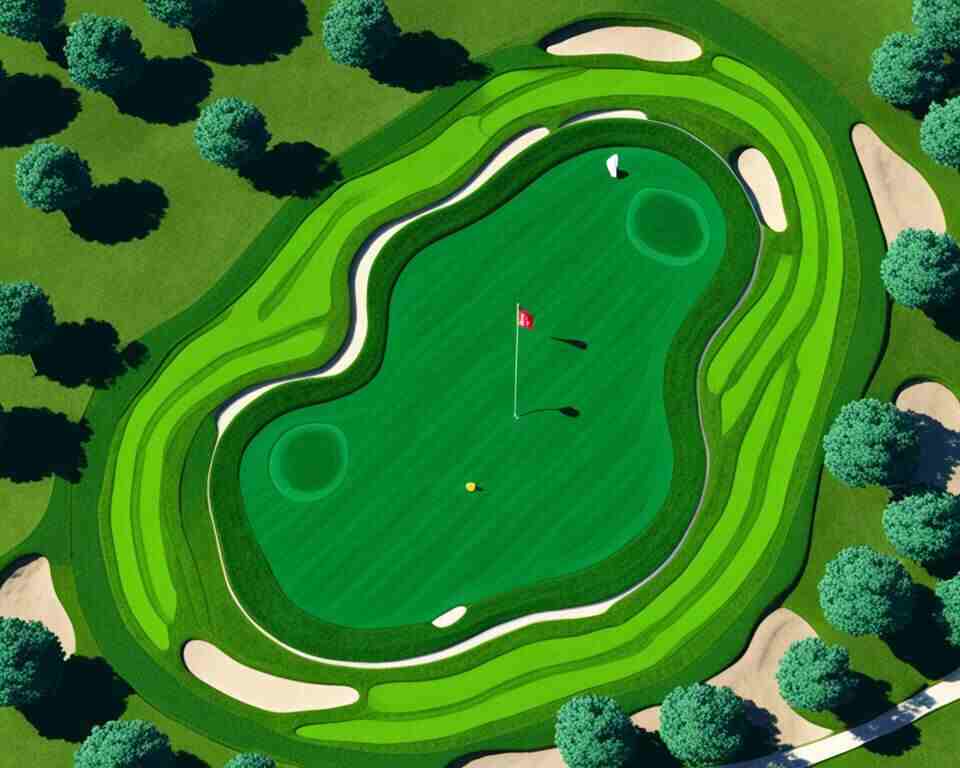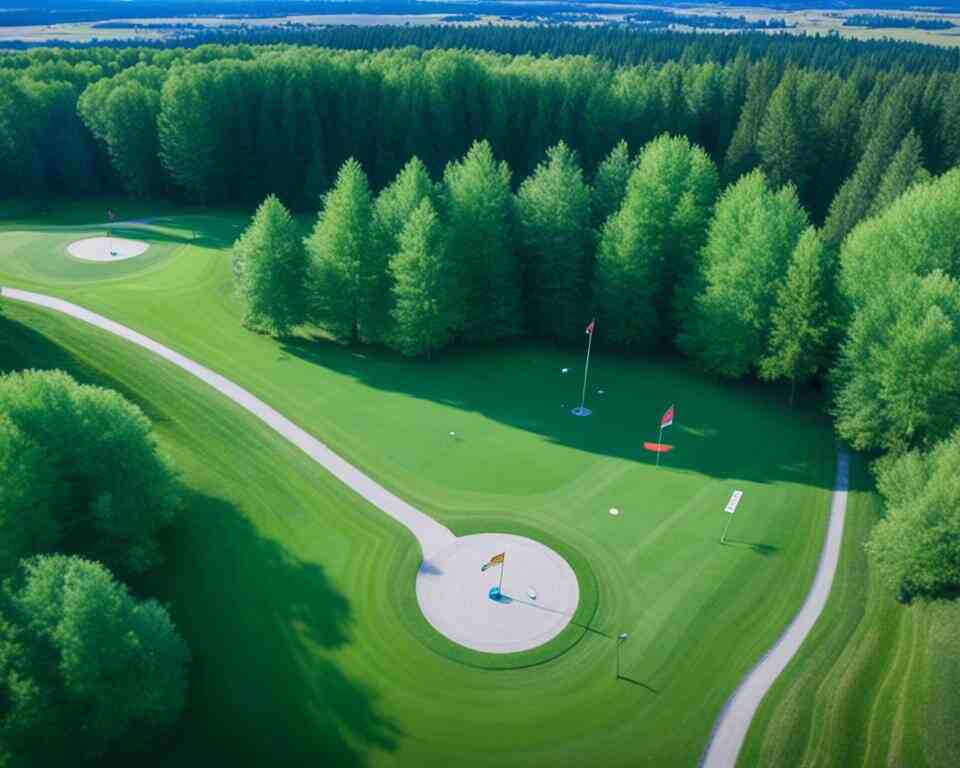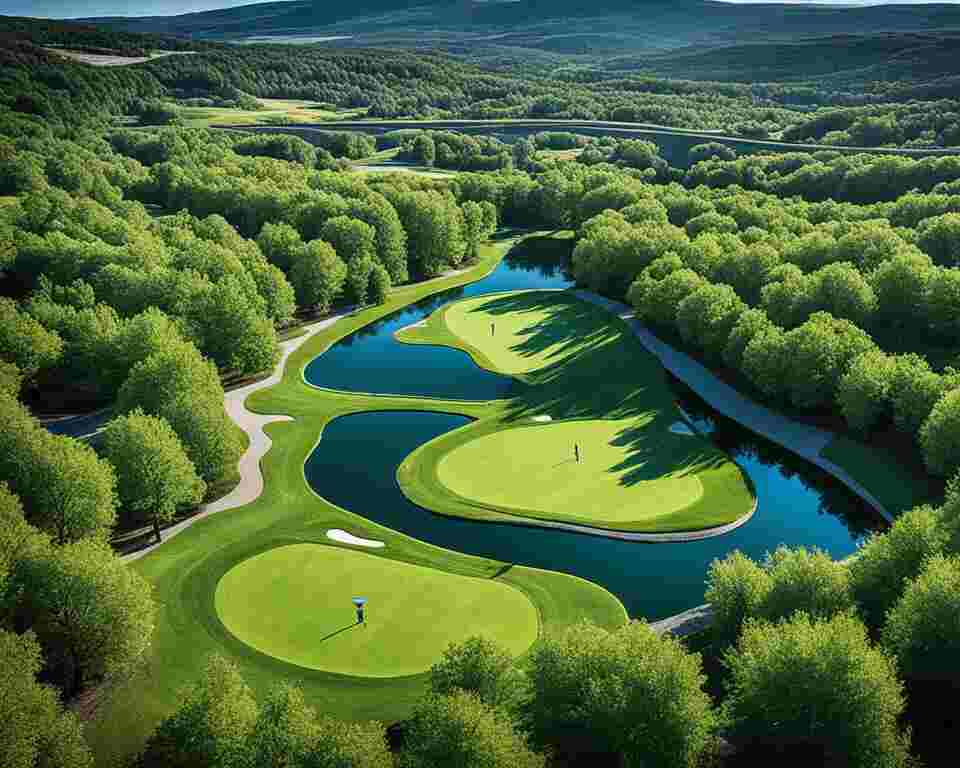Have you ever wondered how big disc golf courses really are? Are they sprawling landscapes with acres of land dedicated to this popular sport? Or are they compact and intimate, fitting into smaller recreational areas?
Disc golf is a unique sport that combines the fun of frisbee throwing with the strategic elements of golf. But when it comes to the size of disc golf courses, there seems to be some confusion. So, let’s dive into the dimensions and sizes typically found in disc golf courses, and explore the factors that influence their size.
Key Takeaways:
- Disc golf courses vary in size depending on factors such as terrain, layout, and intended player skill level.
- The average disc golf course occupies around 5-10 acres of land, but the dimensions can vary.
- Recreational courses are usually smaller, while professional or championship-level courses can span larger areas.
- The specific layout and elements of a disc golf course greatly impact its overall size and level of difficulty.
- The available land, terrain, and intended player skill level are key factors that influence the size of a disc golf course.
How Big Are Disc Golf Courses
Disc golf courses can range in size from small recreational courses to large championship-level courses. The size of a disc golf course is often measured in acreage, with the average course occupying around 5-10 acres of land.
However, the precise dimensions can vary depending on various factors, including the number of holes, layout design, and available space. It’s important to consider the specific requirements of the course, such as fairway length, tee areas, and basket placements, in order to determine the overall size of the course.

When determining the size of a disc golf course, the number of holes is a primary consideration. Recreational courses typically have 9 or 18 holes, while championship courses can have even more. Each hole requires a certain amount of space, including the fairway, tee area, and basket placement. The length of the fairways and the spacing between holes also impact the overall dimensions of the course.
In addition to the number of holes, the layout design plays a crucial role in determining the size of a disc golf course. Layouts can range from more straightforward, open fairways to more intricate designs that incorporate obstacles such as trees, water hazards, and elevation changes. Courses with more complex designs may require additional land to accommodate the various elements and create a challenging playing experience.
Furthermore, the available space for the course is a key factor in determining its size. Certain areas may have limited land, which can impact the overall dimensions of the course. Designers must work with the available space and optimize the layout to fit within the designated area while providing a well-balanced and enjoyable playing experience.
Overall, the size of a disc golf course can vary depending on factors such as the number of holes, layout design, and available space. By considering these factors, course designers can create courses that cater to different skill levels and offer diverse challenges to players.
Understanding Disc Golf Course Dimensions
When it comes to disc golf courses, understanding their dimensions is essential for both players and course designers. In this section, we will look into the typical size of disc golf courses, the variances in course layouts, and the factors that influence course size.
Typical Disc Golf Course Size
On the other hand, professional or championship-level disc golf courses span larger areas, usually ranging from 10-20 acres or more. These courses are designed to challenge experienced players and often feature longer fairways and more complex layouts.
Variances in Disc Golf Course Layouts
The layout of a disc golf course can vary significantly based on the designer’s vision and available space. Some courses may have a straightforward layout, featuring clear paths from tee to basket and straightforward fairways. Others may incorporate more challenging elements, such as dense forests, water hazards, or elevation changes.
These variations in disc golf course layouts not only impact the overall size of the course but also influence the level of difficulty and enjoyment for players. Each layout presents unique challenges and strategic opportunities, adding to the excitement of the game.
Factors Influencing Course Size
Several factors can influence the size of a disc golf course. One significant factor is the availability of land or space. Courses with limited space may need to adapt their layout and reduce the overall size of the course to fit within the available area.
The terrain of a location is another influential factor. Different landscapes may require more or less space for fairways and holes. Courses situated in hilly regions may have longer fairways to accommodate the elevation changes, while courses in flat terrains may have shorter fairways while incorporating other challenging elements to increase the difficulty.
Additionally, the intended player skill level can also determine the size of a course. Recreational courses, designed for beginners and casual players, may be smaller and more beginner-friendly. In contrast, championship-level courses, intended for advanced players, may require larger areas to accommodate a higher level of difficulty.
| Factors Influencing Disc Golf Course Size | Description |
|---|---|
| Available Land | The amount of space or land available for designing the course. |
| Terrain | The natural features of the landscape, such as hills or water bodies, which may require more or less space for fairways and holes. |
| Player Skill Level | The intended skill level of the players the course is designed for, with championship-level courses requiring larger areas to accommodate higher difficulties. |

Designing a Disc Golf Course: Acreage and Facility Requirements
When designing a disc golf course, it’s crucial to maximize the available terrain and space. By leveraging the natural features of the land, such as hills, forests, and water, course designers can create holes that are both interesting and challenging. This not only adds excitement to the game but also enhances the overall aesthetics of the course. Moreover, proper spacing between holes should be considered to ensure players have enough room to navigate between fairways without interference.
Disc golf courses comprise various elements that contribute to their design and functionality. Tee areas serve as designated starting points for each hole and may vary in size and material used. Well-designed tee areas provide players with a solid foundation for their throws and contribute to a smoother gameplay experience.
Additionally, signs strategically placed throughout the course provide players with essential information, including the hole’s par, distance, and potential obstacles to consider. These signs offer guidance and enhance players’ decision-making processes as they progress through the course.
Finally, the targets, or baskets, represent the ultimate goal of completing each hole. These targets are strategically positioned to create a challenge for players while maintaining fair gameplay.
Disc golf courses can be categorized into two main types: standard and championship. Standard courses typically feature shorter fairways, simpler layouts, and cater to a broader range of skill levels.
These courses are ideal for recreational players and beginners looking to test their skills. On the other hand, championship courses are designed for more advanced players seeking a greater level of challenge.
These courses often feature longer fairways, more intricate layouts, and stricter guidelines for basket placement and distance. Organizations like the Professional Disc Golf Association (PDGA) establish specific specifications for each course type to ensure uniformity and fairness in competitive play.

In conclusion, designing a disc golf course involves leveraging the natural features of the land, maximizing space, and carefully considering the various course elements. By utilizing the available terrain, course designers can create unique and challenging holes that enhance players’ experience. Whether it’s optimizing tee areas, strategically placing signs, or adhering to standard or championship course specifications, every aspect contributes to the overall quality and functionality of the course.
Conclusion
Disc golf courses come in a variety of sizes and dimensions, catering to different skill levels and player preferences. From small recreational courses to large championship layouts, there are options available for everyone. The dimensions of a disc golf course are influenced by factors such as the available land, terrain, and the desired level of challenge.
Understanding the dimensions of a disc golf course is crucial when designing and building a course that meets the needs of both the players and the local community. By leveraging the natural terrain and space, course designers can create unique and engaging layouts. Consideration should also be given to course elements such as tees, signs, and targets, which play a significant role in the functionality and enjoyment of the course.
Whether adhering to standard specifications for a more inclusive experience or following championship guidelines for a challenging competition, a well-designed disc golf course offers players of all skill levels an opportunity to hone their skills and have fun. So, if you’re passionate about disc golf or looking to try a new outdoor activity, be sure to explore the disc golf courses in your area and experience the thrill of this exciting sport firsthand.

